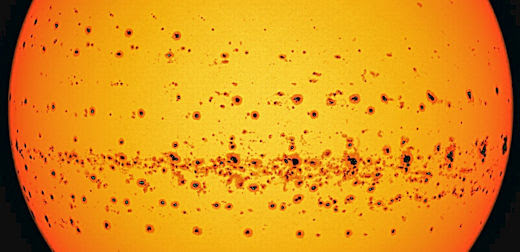Thu, 22 May 2025 10:35:27pm
Related Tags: Sunspot counts 2024, Solar Cycle 25 activity, Great Halloween Storms 2003, Solar storms impact, High solar activity 2024
Sunspot Frenzy: Is the Sun Poised for Another Mega-Storm
Sunspot Frenzy: Is the Sun Poised for Another Mega-Storm
The sun is heating up—literally. For the first time in 23 years, sunspot counts have soared to record levels. As scientists scramble to understand this unexpected surge, memories of the cataclysmic Great Halloween Storms of 2003 come rushing back. Could we be on the brink of another solar tempest?
The sun is behaving like it's 2001 all over again. Recent data from the Royal Observatory of Belgium's Solar Influences Data Analysis Center reveals that the monthly average sunspot number for July 2024 hit an astonishing 196.5. This is the highest count since December 2001, and it has scientists and skywatchers buzzing with both excitement and concern.
Solar Cycle 25: The Unanticipated Powerhouse
When Solar Cycle 25 began in December 2019, experts predicted it would follow in the footsteps of its predecessor, Solar Cycle 24, and remain relatively weak. Instead, it has defied expectations, outpacing Solar Cycle 24 and showing signs that it might rival some of the strongest cycles of the 20th century.
In May 2024, we experienced a geomagnetic storm of century-class magnitude, with stunning auroras lighting up skies in the South Pacific, Central America, and South Africa. This surge in solar activity raises the question: Are we witnessing the peak, or "Solar Max," of Solar Cycle 25?
 Source: spaceweather
Source: spaceweather
A Flashback to the Great Halloween Storms
The last time sunspot numbers were this high, the sun unleashed the Great Halloween Storms of 2003. These storms included the most potent X-ray solar flare ever recorded (X45) and a coronal mass ejection (CME) so powerful it was detected by the Voyager spacecraft at the edge of our solar system.
As sunspot counts rise, there’s a growing sense of déjà vu. Scientists are keeping a close eye on the sun, wary that similar, if not more intense, solar storms could be on the horizon.
The Implications of High Solar Activity
Increased sunspot activity is more than just a skywatcher's delight. It can have significant impacts on our planet and technological infrastructure. High solar activity can lead to geomagnetic storms that disrupt satellite communications, GPS systems, and even power grids.
Auroras, while beautiful, are a visible manifestation of the intense geomagnetic activity caused by solar storms. For those in high-latitude regions, these natural light shows are becoming more frequent and vibrant.
What's Next?
While it’s too early to definitively call this the peak of Solar Cycle 25, the signs suggest we are in for at least 2 to 3 more years of heightened solar activity. Scientists will continue to monitor the sun closely, using advanced space weather forecasting tools to predict and mitigate the impacts of potential solar storms.
Key Points:
- Sunspot Surge: July 2024's sunspot numbers hit a 23-year high, reminiscent of December 2001.
- Unexpected Strength: Solar Cycle 25, predicted to be weak, has outperformed expectations, surpassing Solar Cycle 24.
- Historical Echo: High sunspot activity brings memories of the Great Halloween Storms of 2003, with potential for similar solar events.
- Geomagnetic Impact: Increased solar activity can disrupt technology and create stunning auroras, particularly in high-latitude regions.
- Future Forecast: Expect 2 to 3 more years of elevated solar activity, with scientists closely monitoring for potential solar storms.




